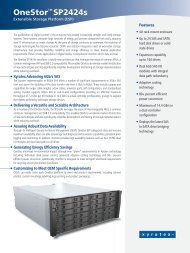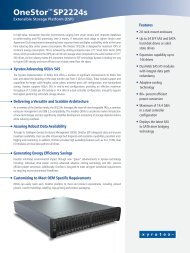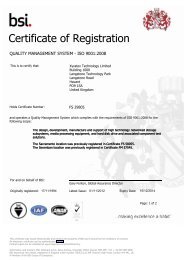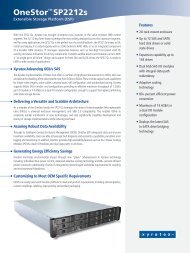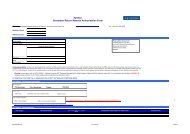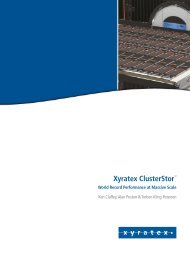In addition to the rapid growth of data, enterprises face the challenge of managing theaccessibility, prioritization and protection of data in a cost-efficient manner. The realization that not alldata is of equal value is driving a proliferation of storage and networking technologies developed toaddress different data management requirements. These technologies include:• High-Speed Network Interface Connections to Hosts or Servers: Storage Area Networks, or SANs,are moving from a legacy base of one gigabit and two gigabit Fibre Channel to four gigabit andten gigabit Fibre Channel. The convergence of networking and storage technology is continuing,offering additional internet protocol, or IP, storage options, such as 10 Gigabit Ethernet andiSCSI for the host connections. Gigabit Ethernet is also widely deployed within the NetworkAttached Storage, or NAS market and we believe will follow the IP storage roadmaps.• High-Speed Connections from Remote Storage Controllers to Storage Subsystems: These connectionsare following the enterprise disk drive connection roadmap and we believe will move to higherspeeds and new interfaces, such as four gigabit Fibre Channel and SAS.• High-Speed Disk Drive Interface Connections: Disk drives are maintaining the historic trend ofdelivering ever faster connections speeds and new interfaces, such as four gigabit Fibre Channel,SAS and Serial ATA, or SATA.A proliferation of technologies has emerged to address the complex requirements of networkstorage. These changes have led to an increase in technology outsourcing by leading OEMs. Thisenables them to provide a broad range of network storage solutions while maintaining a focus on theircore technologies.The proliferation of new applications that enable the electronic distribution of media-rich content,such as digital music and video, is also fueling a rapid increase in the use of disk drive technologies tomanage consumer driven storage demand. New disk drive markets include digital video recorders,digital music players, gaming consoles and home networking, in addition to traditional personalcomputer, or PC, related markets. Non-PC applications of disk drives, such as in the consumerelectronics segments, are projected to grow at a compound annual growth rate of 34.6% between 2005and 2009, according to Gartner Dataquest*, an independent research group.Storage and Network Systems MarketThe increased complexity caused by the proliferation of new technology and applications makes itdifficult for information technology professionals to manage data, make data available to users, storedata reliably, and control all of the costs related to data storage. Networked data storage, includingSANs and NAS, provide solutions to these data management issues by combining the benefits of datastorage and networking technologies. A SAN connects multiple computer servers to a shared pool ofstorage resources using a dedicated high-performance network. A NAS system is an external storagesystem that is directly attached to a Local Area Network, or LAN, which allows all computer terminalson the LAN to have access to the data stored on that external disk storage system.The emergence of new high-speed, low-cost, storage technologies, such as SATA and iSCSI,combined with more costly, higher performance enterprise storage technologies, such as Fibre Channeland SCSI, have created completely new storage system architectures and markets that have yet to fullyemerge. For example, IDC identified a new high growth market segment: Capacity Optimized DiskStorage Systems. IDC forecasts that this segment will grow from $1.7 billion in 2004 to $10.2 billion in2009, representing a compound annual growth rate of 42.4%. This new segment incorporates high* Gartner Dataquest ‘‘Forecast: Hard Disk Drives, Worldwide, 2005-2009’’. Author: John Monroe,dated April 2005.22
capacity desktop disk drives into enterprise class storage systems. One example of user application inthis segment is the growing trend of replacing magnetic tape systems with disk storage systems forfaster back-up and retrieval processes. Another application is specifically targeted at the unique storagerequirements in support of long-term data storage driven by new legislation, e.g. images of signedchecks. This market segment was dominated by high capacity ATA and SATA disk drives in 2005 but asthe market develops new technologies, such as SAS, are also expected to be deployed to addressspecific market requirements. Additionally, according to IDC, disk storage systems connecting to SANsthrough iSCSI protocol will grow from less than $119 million in 2004 to $4.6 billion in 2009,representing a compound annual growth rate of 108.2% during the period.Networked storage offers numerous benefits, including the ability to share data across anorganization using different computing systems, simplified management through centralizedadministration of multiple storage devices, and scalability by allowing the number of storage devices ona network to be increased without interrupting data access. The market for Fabric SAN attachedStorage Systems is comprised of the Fibre Channel & iSCSI technology sub markets. Using dataprovided by IDC we estimate that the Fabric SAN revenues had over 90% share of the total SANmarket in 2005. We also estimate that the market for Fabric SAN attached Storage Systems, will growfrom $7.4 billion in 2004 to $14.5 billion by 2009, representing a compound annual growth rate of14.4%. IDC also project the NAS market to grow from $1.8 billion in 2004 to $3.3 billion in 2009,representing a compound annual growth rate of 12.9%. These two network storage market segmentsare gaining market share within the overall external storage systems market, which is projected to growfrom $15.3 billion dollars in 2004 to $20.9 billion in 2009, representing a compound annual growth rateof 6.4%. The combined market share of NAS and Fabric SAN was 60.6% of the external storagesystems market in 2004 and is estimated to grow to 85% in 2009, at the expense of the Direct AttachedStorage legacy technology base. The networked storage market segments are the fastest growingsegments of the external Storage Systems technology market as a result of companies migrating theirstorage environments away from direct server-attached architectures.These storage networks enable the widespread distribution of data and provide easier access toshared information. However, they also place a strain on the ability of enterprises to manage businesscriticaldata. Furthermore, the mission-critical nature of much enterprise data has placed a premium ondata management software applications that provide reliability, availability and scalability in complexheterogeneous computing environments. As a result, major OEMs are increasingly allocating internalresources and developing strategies to provide software and service solutions to address thisopportunity while developing strategic relationships with storage subsystem vendors to outsourceincreasingly complex hardware subsystem requirements.The increasing amount of data that needs to be stored and accessed with the appropriate level offlexibility and reliability presents a significant challenge to data storage system design. The fundamentalchallenge faced by information technology managers is to effectively manage the high-growth rate ofdata and to make that data available across their organizations in a reliable and scalable fashion. Theadvent of RAID and other networked storage technologies have helped address many of thecomplexities associated with the management of increased amounts of data. RAID storage subsystemsconsist of multiple disk drives together with a controller device that manages access to data stored onthe disk drives. The controller manages access to the data so that if a disk drive fails, other disk drivesin the RAID subsystem can be used to recover data that was lost from the affected disk drive.Due to their high levels of performance and reliability, RAID storage systems have become theprevailing technology for businesses where data availability is of critical importance. Historically, wehave addressed this need by either integrating our storage enclosures with either our customer’s storagecontroller or specialist third party controller technology. The adoption rate of RAID enabled dataprotection strategies has been less marked in the Entry sub-segment and certain Mid Rangesub-segments, which service the Small and Medium Enterprise, or SME, sector. However, affordable23
- Page 3: XYRATEX LTDANNUAL REPORT FOR THE YE
- Page 6 and 7: INTRODUCTIONWe are incorporated und
- Page 8 and 9: Year Ended November 30,2005 2004 20
- Page 10 and 11: The computations for the weighted a
- Page 12 and 13: The markets in which we operate are
- Page 14 and 15: technological capabilities. This co
- Page 16 and 17: may cease production of components,
- Page 18 and 19: • potentially adverse tax consequ
- Page 20 and 21: We could incur substantial costs, i
- Page 22 and 23: influence by voting at a meeting of
- Page 24 and 25: Xyratex Ltd to the former sharehold
- Page 28 and 29: RAID controller technology is proje
- Page 30 and 31: Our Competitive StrengthsDisk drive
- Page 32 and 33: the storage subsystem and disk driv
- Page 34 and 35: Our storage subsystems are internal
- Page 36 and 37: systems are capable of testing a fu
- Page 38 and 39: Research and DevelopmentWe have ove
- Page 40 and 41: • sets forth procedures for the p
- Page 42 and 43: Item 4C: Organization StructureXyra
- Page 44 and 45: ecame the parent company of our bus
- Page 46 and 47: Foreign Exchange Rate FluctuationsT
- Page 48 and 49: we recorded in the year ended Novem
- Page 50 and 51: Fiscal Year Ended November 30, 2005
- Page 52 and 53: Research and Development—otherThe
- Page 54 and 55: Fiscal Year Ended November 30, 2004
- Page 56 and 57: Selling, General and Administrative
- Page 58 and 59: Quarterly Results of OperationsThe
- Page 60 and 61: sales growth. The increase in defer
- Page 62 and 63: choose to make or alliances we have
- Page 64 and 65: compete. Identifiable intangible as
- Page 66 and 67: ITEM 6: DIRECTORS, SENIOR MANAGEMEN
- Page 68 and 69: Ernest Sampias has served as a dire
- Page 70 and 71: Audit CommitteeOur Audit Committee
- Page 72 and 73: Employee Benefit/Share Option Plans
- Page 74 and 75: The maximum amount that any partici
- Page 76 and 77:
Restricted StockRestricted stock aw
- Page 78 and 79:
the options, warrants or rights, bu
- Page 80 and 81:
Quarterly high and low market price
- Page 82 and 83:
whose functional currency is not th
- Page 84 and 85:
on the Nasdaq National Market and,
- Page 86 and 87:
Interest RatesWe had cash and cash
- Page 88 and 89:
aggregate in any fiscal year and th
- Page 90 and 91:
(This page has been left blank inte
- Page 92 and 93:
XYRATEX LTDAUDITED CONSOLIDATED BAL
- Page 94 and 95:
F-4XYRATEX LTDAUDITED CONSOLIDATED
- Page 96 and 97:
XYRATEX LTDNOTES TO AUDITED CONSOLI
- Page 98 and 99:
XYRATEX LTDNOTES TO AUDITED CONSOLI
- Page 100 and 101:
XYRATEX LTDNOTES TO AUDITED CONSOLI
- Page 102 and 103:
XYRATEX LTDNOTES TO AUDITED CONSOLI
- Page 104 and 105:
XYRATEX LTDNOTES TO AUDITED CONSOLI
- Page 106 and 107:
XYRATEX LTDNOTES TO AUDITED CONSOLI
- Page 108 and 109:
XYRATEX LTDNOTES TO AUDITED CONSOLI
- Page 110 and 111:
XYRATEX LTDNOTES TO AUDITED CONSOLI
- Page 112 and 113:
XYRATEX LTDNOTES TO AUDITED CONSOLI
- Page 114 and 115:
XYRATEX LTDNOTES TO AUDITED CONSOLI
- Page 116 and 117:
XYRATEX LTDNOTES TO AUDITED CONSOLI
- Page 118 and 119:
XYRATEX LTDNOTES TO AUDITED CONSOLI
- Page 120 and 121:
XYRATEX LTDNOTES TO AUDITED CONSOLI
- Page 122 and 123:
XYRATEX LTDNOTES TO AUDITED CONSOLI
- Page 124 and 125:
XYRATEX LTDNOTES TO AUDITED CONSOLI
- Page 126 and 127:
XYRATEX LTDNOTES TO AUDITED CONSOLI
- Page 128 and 129:
XYRATEX LTDNOTES TO AUDITED CONSOLI
- Page 130:
(This page has been left blank inte



